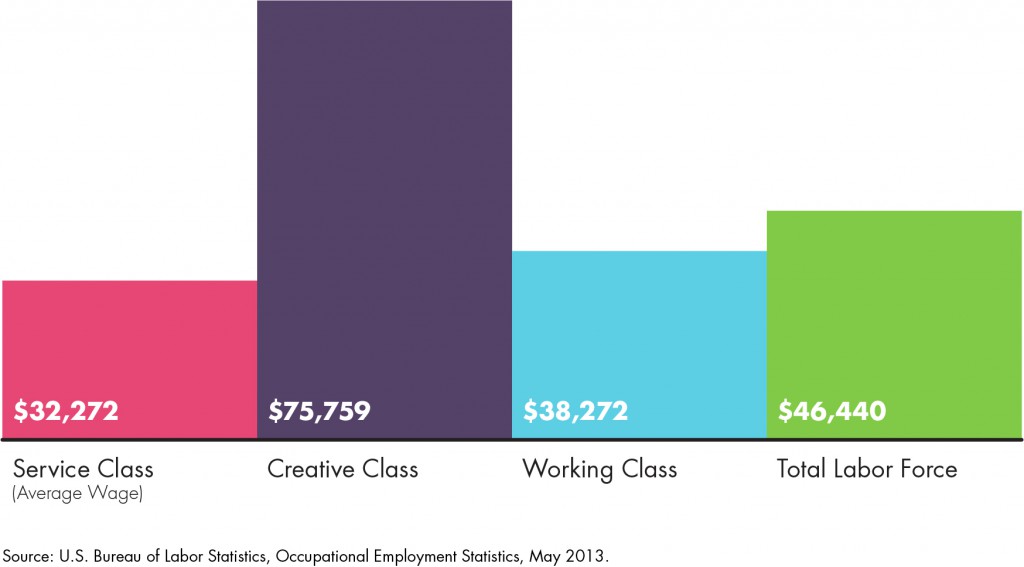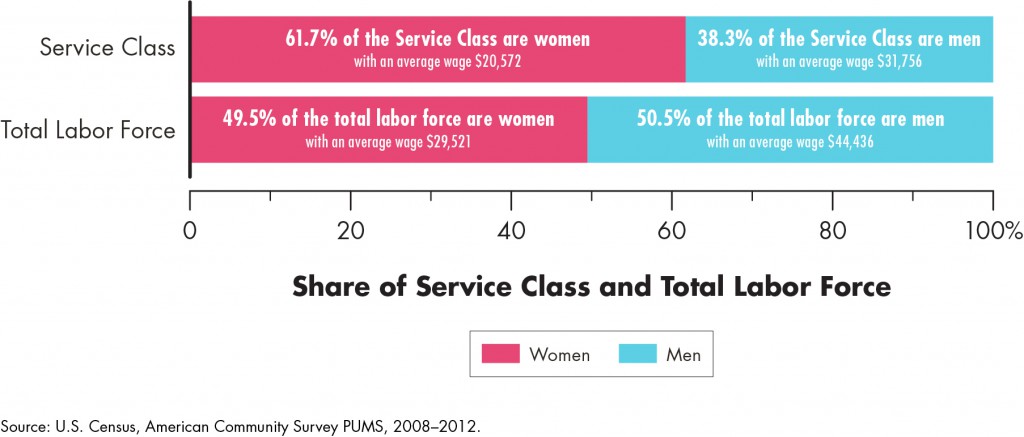Capitalism is in the throes of a massive transformation from an industrial-based system to a knowledge-based economic model. As this shift occurs, the class structure of modern society is also changing. Today, society is made up of three main classes or types of workers: the declining blue-collar Working Class, the rising Creative Class of knowledge workers, professionals, and artists, and the even larger Service Class, which is the focus of the Martin Prosperity Institute’s report: Building 65 Millions Jobs: The Geography of Low-Paid Service Class Jobs and How to Begin to Upgrade Them.
The Service Class is by far the biggest class. It includes 65 million workers — almost half of the labor force — who toil in precarious, low-skill, low-pay jobs in fields like Food Preparation and Service, Retail Trade, Personal Care, and Clerical and Administrative positions.
This report outlines their dramatic growth, documents the low wages paid to Service Class workers, and charts the large share of women and minorities that make up Service Class workers.
As Exhibit 1 shows, the Service Class is the most poorly paid class by far. Members of the Service Class make just $32,272 on average, roughly 30 percent less than the national average of $46,440, less than half of the $75,759 average for Creative Class workers, and 15 percent less than the $38,272 average for the Working Class.
Exhibit 1: Average Wage by Class, 2013
The wages of the Service Class have eroded over the past decade, as Exhibit 2 shows. In 2003, Service Class workers made roughly three-quarters of the average annual wage for all U.S. workers. By 2013, however, this had declined to less than 70 percent.
Exhibit 2: Service Class Wage Ratios for 2003 and 2013
The key findings of the report include:
- The Service Class makes up the largest segment of the U.S. workforce, employing 65 million Americans, nearly half of all workers.
- The members of the Service Class toil in low paid jobs, making slightly more than $32,000 on average, while positions in Food Service and Personal Care professions, in which more than 15 million Americans work, pay even less, roughly $25,000.
- Service Class jobs not only pay less than other jobs, Service Class workers in expensive states and metros end up with far less money left over after paying for their housing.
- The Service Class is disproportionately made up of women who hold more than six in 10 of all low-wage Service jobs. And, roughly 60 percent of women (58.1 percent) in the labor force do service class work compared to just 36.8 percent of men. More troublingly, women in Service Class jobs make considerably less than men, averaging $20,572 for Service Class work compared to $31,756 for men (see Exhibit 3).
- There are also much higher concentrations of minorities in the Service Class. More than half of Black (55 percent) and Hispanic-Latino workers do Service Class jobs compared to 45 percent of Whites and 40 percent of Asians.
Exhibit 3: The Service Class by Gender
The report outlines a set of strategies for upgrading Service Class jobs in order rebuild the American middle class. The best and most competitive companies in this sector offer low prices and turn a profit because they pay workers more, treat them well, and involve them in productivity enhancement and better customer service. This “good jobs strategy” combines operational excellence with an investment in workers themselves. Through higher pay and greater engagement, companies can tap into the productivity and innovation of workers to create greater profits. If we are to overcome our economic divides, it is imperative that we upgrade this work now.
Download this Insight (PDF)


